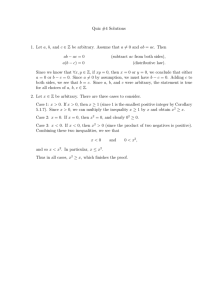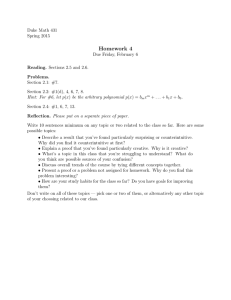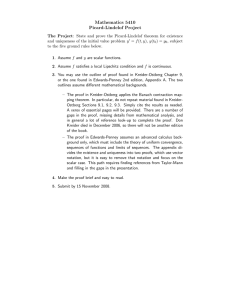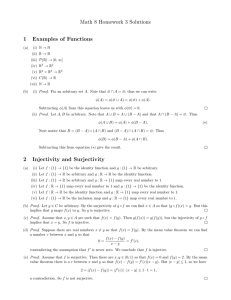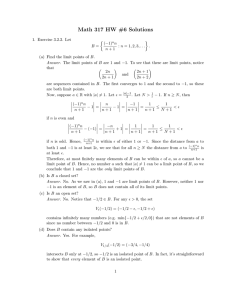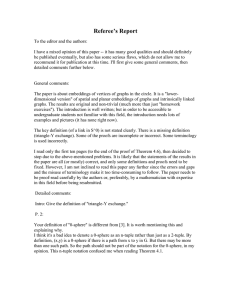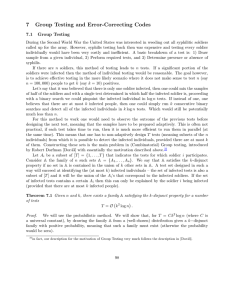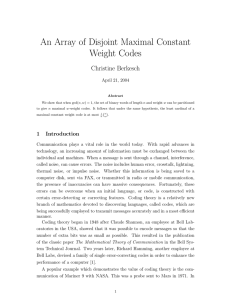University of South Alabama Fall Semester 2012 Monday, August 27, 2012.
advertisement
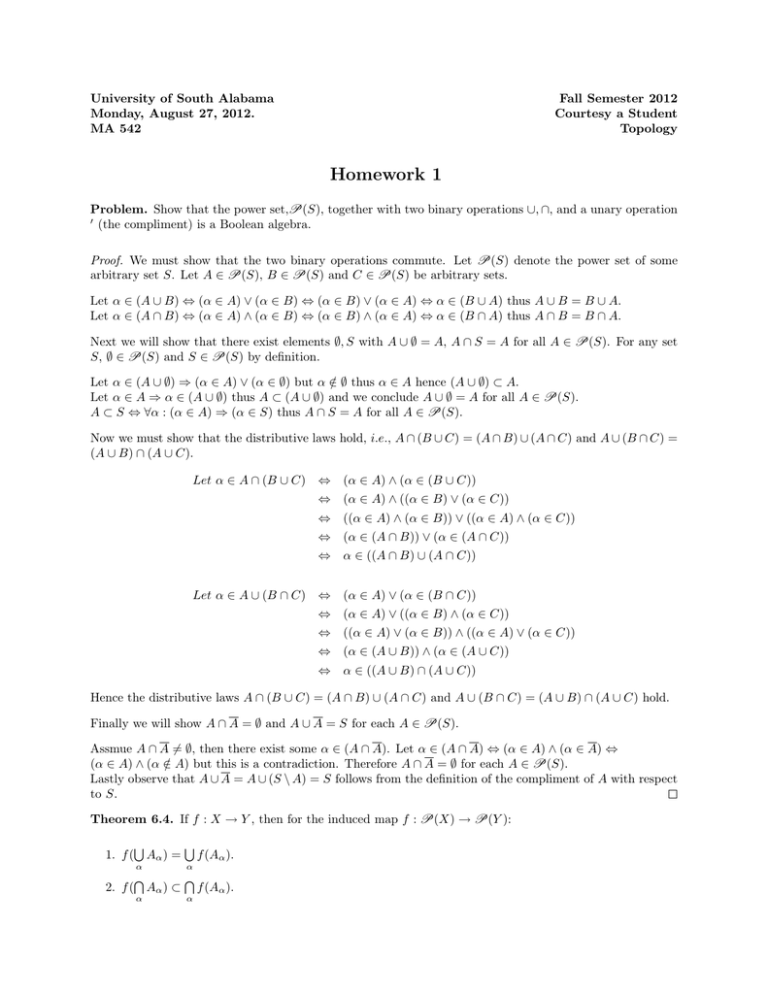
University of South Alabama
Monday, August 27, 2012.
MA 542
Fall Semester 2012
Courtesy a Student
Topology
Homework 1
Problem. Show that the power set,P(S), together with two binary operations ∪, ∩, and a unary operation
(the compliment) is a Boolean algebra.
0
Proof. We must show that the two binary operations commute. Let P(S) denote the power set of some
arbitrary set S. Let A ∈ P(S), B ∈ P(S) and C ∈ P(S) be arbitrary sets.
Let α ∈ (A ∪ B) ⇔ (α ∈ A) ∨ (α ∈ B) ⇔ (α ∈ B) ∨ (α ∈ A) ⇔ α ∈ (B ∪ A) thus A ∪ B = B ∪ A.
Let α ∈ (A ∩ B) ⇔ (α ∈ A) ∧ (α ∈ B) ⇔ (α ∈ B) ∧ (α ∈ A) ⇔ α ∈ (B ∩ A) thus A ∩ B = B ∩ A.
Next we will show that there exist elements ∅, S with A ∪ ∅ = A, A ∩ S = A for all A ∈ P(S). For any set
S, ∅ ∈ P(S) and S ∈ P(S) by definition.
Let α ∈ (A ∪ ∅) ⇒ (α ∈ A) ∨ (α ∈ ∅) but α ∈
/ ∅ thus α ∈ A hence (A ∪ ∅) ⊂ A.
Let α ∈ A ⇒ α ∈ (A ∪ ∅) thus A ⊂ (A ∪ ∅) and we conclude A ∪ ∅ = A for all A ∈ P(S).
A ⊂ S ⇔ ∀α : (α ∈ A) ⇒ (α ∈ S) thus A ∩ S = A for all A ∈ P(S).
Now we must show that the distributive laws hold, i.e., A ∩ (B ∪ C) = (A ∩ B) ∪ (A ∩ C) and A ∪ (B ∩ C) =
(A ∪ B) ∩ (A ∪ C).
Let α ∈ A ∩ (B ∪ C) ⇔ (α ∈ A) ∧ (α ∈ (B ∪ C))
⇔ (α ∈ A) ∧ ((α ∈ B) ∨ (α ∈ C))
⇔ ((α ∈ A) ∧ (α ∈ B)) ∨ ((α ∈ A) ∧ (α ∈ C))
⇔ (α ∈ (A ∩ B)) ∨ (α ∈ (A ∩ C))
⇔ α ∈ ((A ∩ B) ∪ (A ∩ C))
Let α ∈ A ∪ (B ∩ C) ⇔ (α ∈ A) ∨ (α ∈ (B ∩ C))
⇔ (α ∈ A) ∨ ((α ∈ B) ∧ (α ∈ C))
⇔ ((α ∈ A) ∨ (α ∈ B)) ∧ ((α ∈ A) ∨ (α ∈ C))
⇔ (α ∈ (A ∪ B)) ∧ (α ∈ (A ∪ C))
⇔ α ∈ ((A ∪ B) ∩ (A ∪ C))
Hence the distributive laws A ∩ (B ∪ C) = (A ∩ B) ∪ (A ∩ C) and A ∪ (B ∩ C) = (A ∪ B) ∩ (A ∪ C) hold.
Finally we will show A ∩ A = ∅ and A ∪ A = S for each A ∈ P(S).
Assmue A ∩ A 6= ∅, then there exist some α ∈ (A ∩ A). Let α ∈ (A ∩ A) ⇔ (α ∈ A) ∧ (α ∈ A) ⇔
(α ∈ A) ∧ (α ∈
/ A) but this is a contradiction. Therefore A ∩ A = ∅ for each A ∈ P(S).
Lastly observe that A ∪ A = A ∪ (S \ A) = S follows from the definition of the compliment of A with respect
to S.
Theorem 6.4. If f : X → Y , then for the induced map f : P(X) → P(Y ):
S
S
1. f ( Aα ) = f (Aα ).
α
α
T
T
2. f ( Aα ) ⊂ f (Aα ).
α
α
Proof.
[
1. Let y ∈ f ( Aα ) ⇔
∃x ∈
α
[
Aα : f (x) = y
α
⇔
∃α : x ∈ Aα s.t. f (x) = y
⇔
∃α : f (x) ∈ f (Aα )
[
[
[
⇔ f (x) ∈
f (Aα ) thus f ( Aα ) =
f (Aα )
α
\
2. Let y ∈ f ( Aα ) ⇒
α
∃x ∈
\
α
α
Aα : f (x) = y
α
⇒
∀α : x ∈ Aα
⇒
∀α : f (x) ∈ f (Aα )
\
\
\
f (Aα )
f (Aα ) thus f ( Aα ) ⊂
⇒ f (x) ∈
α
α
α
T
T
To see that f ( Aα ) 6= f (Aα ) let f : R → R be the constant map x 7→ 2. Then, with A = [0, 1], B = [2, 3],
α
α
we get ∅ = f (A ∩ B) 6= f (A) ∩ f (B) = {2}.
Theorem 6.5. If f : X → Y , then:
1. For each A ⊂ X, f −1 [f (A)] ⊃ A.
2. For each A ⊂ X and B ⊂ Y , f [f −1 (B) ∩ A] = B ∩ f (A); in particular, f [f −1 (B)] = B ∩ f (X).
Proof.
1. Let x ∈ A
⇒ f (x) ∈ f (A)
⇒ x ∈ f −1 (f (A)) thus A ⊂ f −1 [f (A)]
To see that f −1 [f (A)] 6= A let f : R → R be the map x 7→ x2 . Then with A = {2}, we get f (A) = 4 ⇒
f −1 (f (A)) = f −1 (4) = {±2}.
2. Let y ∈ f [f −1 (B) ∩ A] ⇔
⇔
∃x ∈ (f −1 (B) ∩ A) : f (x) = y
x ∈ f −1 (B) ∧ (x ∈ A)
⇔ (α ∈ B) ∧ (α ∈ f (A))
⇔ α ∈ (B ∩ f (A)) thus f [f −1 (B) ∩ A] = B ∩ f (A)
Furthermore if we let A = X, then we get f [f −1 (B)] = B ∩ f (X).



